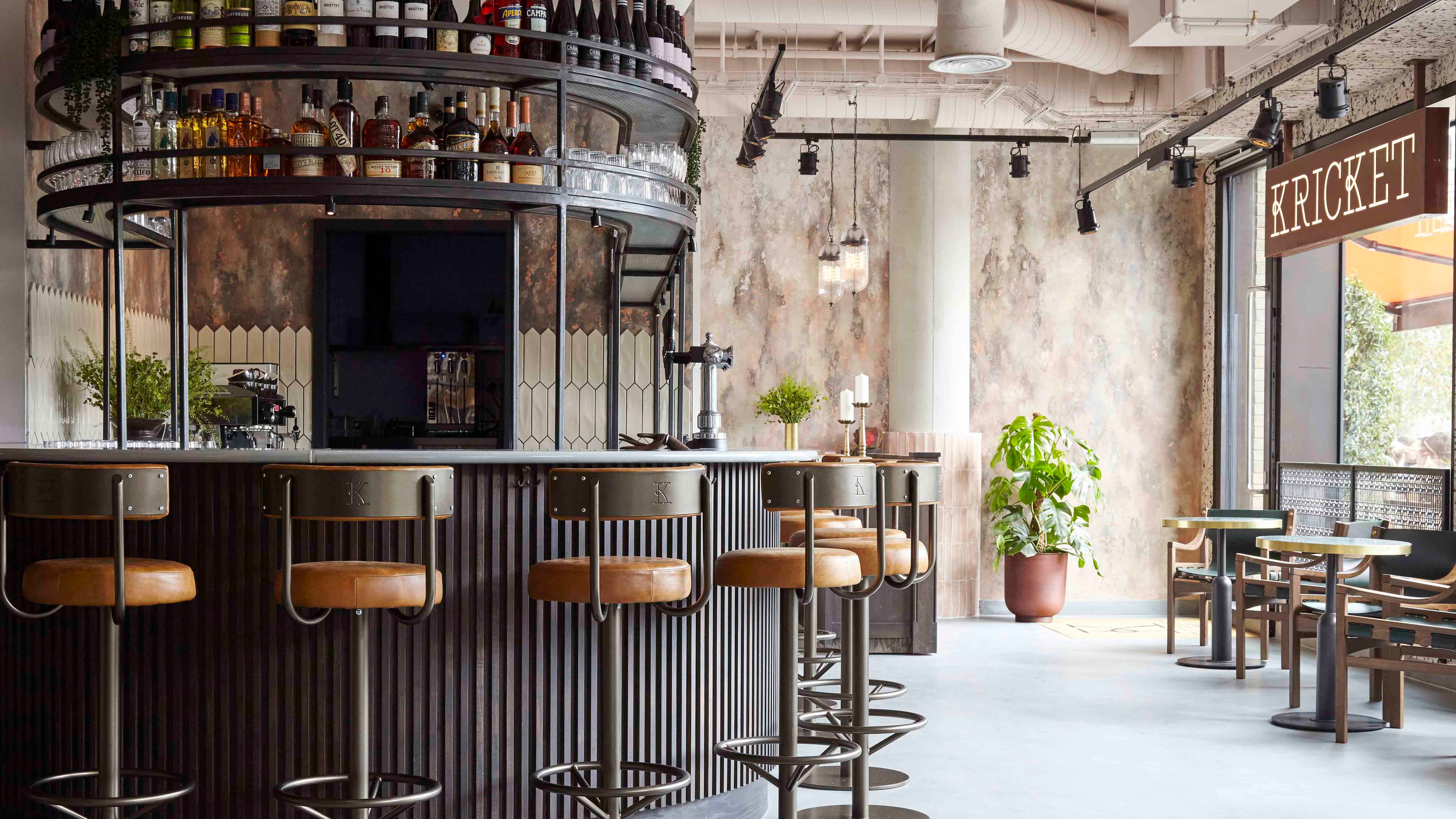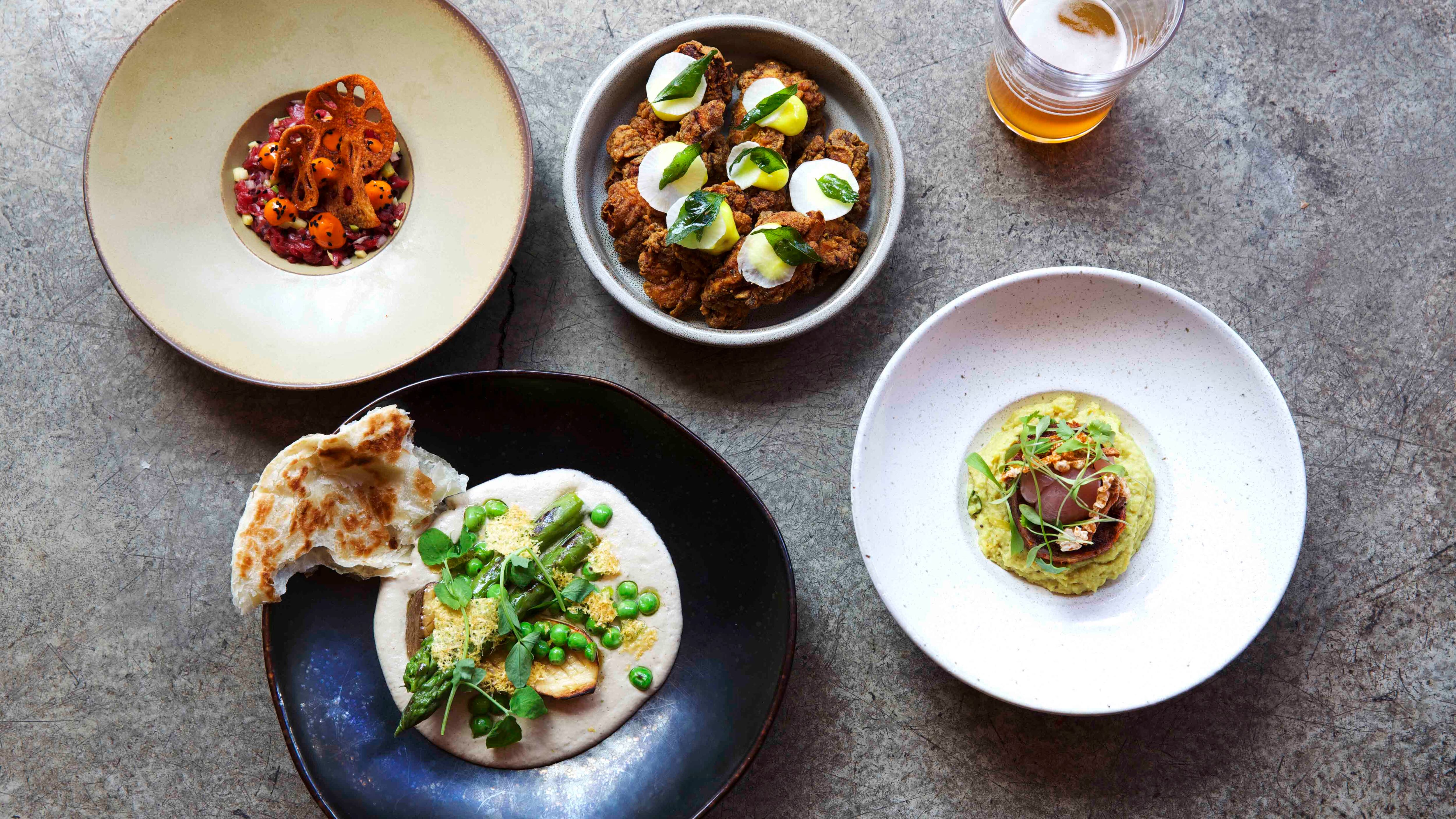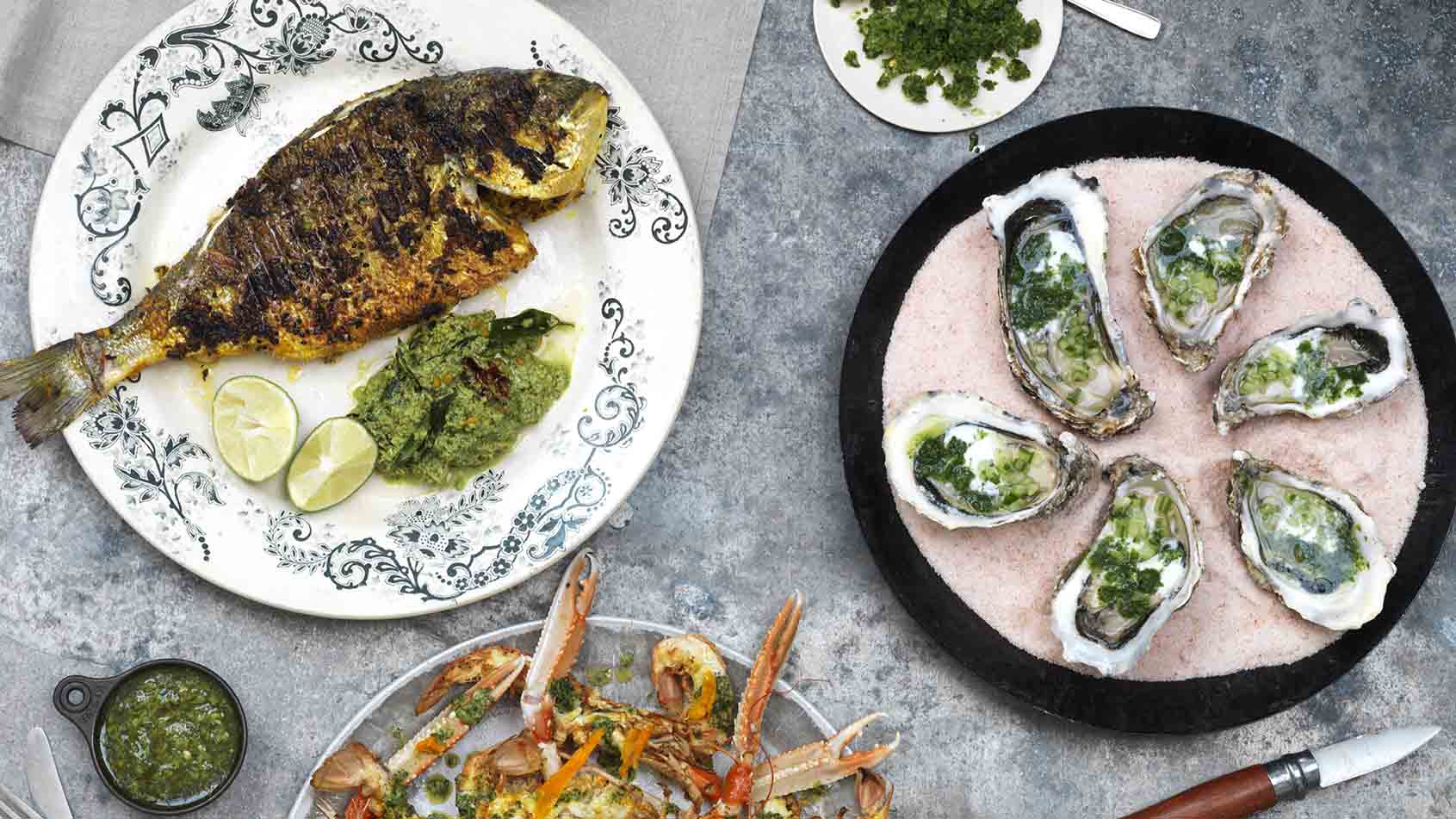Kricket’s aptly named Will Bowlby is not the sort of person one would really associate with a scalable restaurant business.
Classically trained by chefs including Rowley Leigh, he became interested in Indian food while running a European restaurant in Mumbai and later worked for Vivek Singh at Cinnamon Kitchen. He launched Indian small plates restaurant Kricket in 2015 with university mate and business partner Rik Campbell at Pop Brixton to considerable critical acclaim.
With a regularly changing seasonal menu that demands relatively sophisticated from-scratch cooking, the Kricket concept itself isn’t an obvious candidate for a rollout either. Yet three bricks and mortar restaurants have followed in Soho, Brixton and – most recently – at the Television Centre development in west London.
“I’m still going through the transition,” he says when pressed on his attitude to expansion.
“Part of me is reluctant to do it because if you’re a chef you want to be cooking, right? But a bigger part of me has had to realise that you have to step back and train other people and allow them to do your job.”
Happily Campbell isn’t out to take over the world either – he wants to create a “small but valuable” group – and nor is Kricket’s backer Chris Miller of White Rabbit Fund, with whom the pair started working a day or two after signing the lease on their Soho restaurant in late 2016.
“We had a number of offers on the table at that point, but the two most serious ones were from Chris and another would-be investor who wanted us to do five restaurants a year for the next four years,” says Campbell, who – prior to Kricket – worked in corporate finance.
Although, at that point, it was just a 20-cover restaurant in a shipping container, Kricket was already a critical and commercial success thanks to Bowlby’s skill in the kitchen and Campbell’s financial nous (the pair’s combo of tasty small plates and affordable cocktails is a potent one, with spend per head currently averaging £34).
“We were [Miller’s] first investment,” continues Campbell.
“He brings a lot more than simply cash to the table. His background prior to restaurants is quite similar to mine, but he’s a bit more of a ‘black belt’ than me. White Rabbit Fund helped us set up a lot of the systems that underpin the business and have been hugely supportive, but they don’t tell us what colour to paint the walls. The creative is all down to us.”
Bowling into new territory
Soho and the second Brixton location (the original shipping container site is now closed) are highly successful restaurants, seating more than 2,000 people a week between them with year-to-date group revenue up 34% on last year.
The pair are hoping to repeat that success with their White City site, which opened late last month. At 100 covers inside and with another 40 on the terrace, it is their largest restaurant by some margin. The location looks likely to be a good fit for Kricket, but it is certainly new territory for the group.
“It’s a different vibe and demographic for sure,” says Campbell.

“We’re not expecting it to be quite as busy from the off as Soho or Brixton. The hope is that this area will become a new centre of gravity for west London. It reminds me a bit of Granary Square (in King’s Cross), four or five years ago. People weren’t sure, but now look at it.”
Another big plus is the relatively low number of restaurants trading alongside them: just Homeslice and Patty & Bun and D&D’s Bluebird Café, although the site is just across the road from Westfield London. Kricket White City has been designed to reference the restaurants that have come before but it’s the pair’s most grown-up, high-spec project to date. On first glance, the group’s restaurants don’t look obviously Indian but look a little closer and you’ll find some subtle – and modern – subcontinental references.
Though the pair were wary of large, purpose-built restaurants, the bigger footprint and flexible layout has allowed for a much more generous back-of-house area than any of the other Krickets with a large open kitchen, a separate staging area for the front-of-house team and – for the first time – a staff room.
Hold the curry
The menus at each of the Kricket restaurants are all different with just a handful of dishes common to all three. Four or so dishes have been carried over from Soho and Brixton, including Kricket classics KFC (Kerala Fried Chicken) and samphire pakoras.
A larger kitchen and restaurant will allow Bowlby to offer more sharing dishes, although the menu will still be focused on small plates.
“The idea behind the dishes is the same, but we like to keep things fresh,” he says.
“Like a lot of restaurants we work seasonally and locally. But there’s a bit of research too. We often look at recipes that are already embedded in Indian food culture. From there, we combine that with quality produce and see if there is anything else we can do to elevate it and make it taste even better, while keeping hold of the authentic taste and flavour.”

Sharing options take in kid goat leg raan with pomegranate, goats’ curd, mint raita and pink onions; and gurnard and palourade clam macher jhol with pickled fennel and fermented ramsons. Small plates include grilled leeks with carom seed paneer kasundi mustard and tarragon; and venison and aged beef fat kebab, greengage chutney, smoked raita and hazelnut.
There’s a higher price point on some of the dishes. The most expensive dish in Soho is £14 (tandoori methi lamb neck) at White City it’s £45 (suckling pig shoulder vindaloo). “But we’re not charging more just because we’re in west London,” says Bowlby.
“It just reflects the size of the dishes and the ingredients.”
“It’s tricky to identify our customer here just yet,” adds Campbell.
“The spend per head in Soho and Brixton is roughly the same but, at the latter, the spend is to some extent propped up by the bar, with people often coming for pre- and post-dinner drinks. We are anticipating a slightly higher spend per head here. We think the food will warrant it.”
As you’d expect, Bowlby is a firm believer that anyone can cook Indian food to a high level.
“It does not matter where you’re from as long as your attitude is right and you want to learn.”
Like other Indian groups, Kricket has to pay a premium for staff that are already skilled in the cooking of the subcontinent.
“Recruitment isn’t too bad at the moment but there are a lot of restaurant groups paying silly money for chefs with Indian cooking skills. So we sometimes feel like we’re being held to ransom,” says Campbell.
“But with that said, we consider our current team our greatest asset,” chips in Bowlby.
“When we started out we only had one Indian staff member alongside some enthusiastic but not very experienced western chefs. Then we went the other way with a team that was nearly completely Indian. We’ve now found that the best food comes from having a good blend of people, which is just as well really as that’s the only approach that’s practical these days.”
Tackling no-shows
The extra space at White City will allow the pair to centralise reservations across the group. No-shows used to be a big headache, but a policy of taking small deposits for bookings of four covers or more pretty much eliminated the problem overnight. The restaurants take card details and if people cancel with less than 24 hours’ notice or fail to show, they are charged £10 per cover.
“We don’t do it often but we’ve found it to be a very effective deterrent. We do look at things on a case-by-case basis. I was on the door at Soho the other night and a lady came in two hours before her booking and cancelled because all her friends had let her down and we didn’t charge her,” says Campbell.
It may serve Indian food, but Kricket does not lend itself to delivery and takeaway – small plates and an absence of curry do not a great Indian off-premises offering make. But Campbell and Bowlby did recently dip their toes in the water with Namma, a delivery-only brand run under a licensing agreement with White Rabbit Fund’s Hutch offshoot.

Trading out of Deliveroo’s dark kitchen in Whitechapel alongside White Rabbit Fund stablemates Andrew Wong and Island Poké, it offered a far more everyman menu of curry house staples. It was shortlived, however, with Namma ceasing trading in August.
“It was a good experience,” says Campbell. “We created a decent menu and brand that we will certainly be using again.”
“Namma was miles away from what we do at Kricket,” interjects Bowlby.
“When I order takeaway, I want comfort food. It’s not an occasion where most people want to broaden their horizons, they want their usual. As such, we focused on authentically Indian versions of curry house classics, including vindaloo and butter chicken.”
Namma is set to make a return at some point but will likely trade from its own bricks-and-mortar site and could even feature a grab-and-go element.
Riding the new wave
The pair are largely unfazed by the steady march of their peers in what can broadly be described as the new-wave Indian sector, although they do admit to accelerating the launch of the inaugural Kricket in Pop Brixton to ensure they were among the first restaurants to market.
Several brands are on the expansion trail in the regions and could conceivably open on Kricket’s doorstep at some point, including Mowgli, Bundobust and The Chilli Pickle. The branded Indian scene in London is far more competitive, with the likes of Dishoom, Gunpowder, MW Eat and JKS Restaurants’ currently duking it out for customers. While Bowlby acknowledges the explosion of high-quality Indian restaurant concepts that has occurred over the past four years or so, he rightly points out that there is a healthy amount of variation between the space’s key players.
“India is a huge and diverse place. Such broad source material has resulted in some very different concepts. The experience at Kricket is very different to a meal at Dishoom. So we don’t really see other Indian operators as our competition. Taking Soho as an example, I think our main competition would be restaurants that are stylistically similar to us, such as The Palomar and Kiln.”
So despite the heightened activity in the sector, Kricket is planning a pause in expansion.
“In order to maintain our brand and the excitement around Kricket, we need to take stock. It’s nice at the moment. We have about 60 staff so we know everyone personally,” says Campbell.
Though they can’t go into detail, there appears to be a plan afoot to open a bar or pub to service those waiting for a table at the Soho site.
“We have a two-hour queue some nights and, currently, we’re feeding that to the pubs and bars around us. We’d like to do something about that in a similar way to what The Palomar owners have done with The Blue Posts,” says Campbell.
Though they won’t rule it out, the pair don’t seem to have much of an appetite for a restaurant in the regions. They’re far more interested in overseas expansion.
“When it comes to Indian food, London is so far ahead. We’d like to use that to our advantage at some point,” says Campbell.
They’ve even considered carrying coal to Newcastle – or to use a more apt metaphor bringing bhajis to Bangalore – and opening a Kricket in the subcontinent.
“India’s restaurant scene does not currently match its reputation for food, but it is starting to catch up. It’s exciting,” says Bowlby. “We think Kricket would work well in one of the big cities.”

